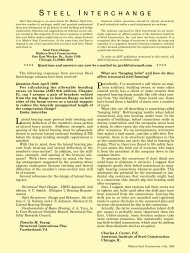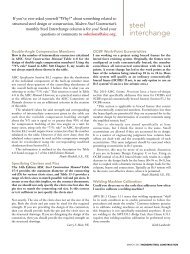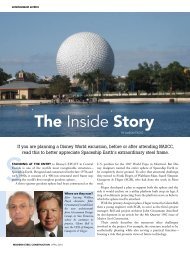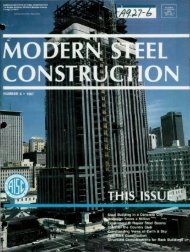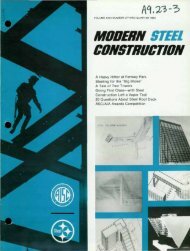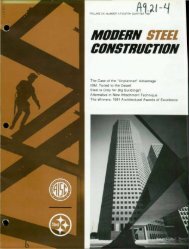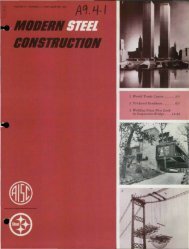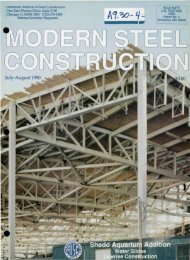THE FATHER OF LRFD - Modern Steel Construction
THE FATHER OF LRFD - Modern Steel Construction
THE FATHER OF LRFD - Modern Steel Construction
Create successful ePaper yourself
Turn your PDF publications into a flip-book with our unique Google optimized e-Paper software.
In 1949, his family immigrated to a<br />
small town in North Dakota and<br />
Galambos got his first job as a yard boy<br />
for a steel fabrication shop. He attended<br />
the University of North Dakota from<br />
1949 until 1954, where he received his<br />
BSCE and MSCE. Galambos said he<br />
stayed on to receive his MSCE because<br />
“I couldn’t get a job because I wasn’t a<br />
U.S. citizen.” He became a citizen in<br />
May 1954 and received his MSCE the<br />
next month.<br />
He immediately began working at<br />
Babcock and Wilcox Company in<br />
Barberton, OH, designing boiler structures.<br />
Ironically, just four months later<br />
Galambos was drafted into the U.S.<br />
Army where he worked on airfield construction<br />
on the missile range in the<br />
Bahamas until April 1956.<br />
Galambos returned to Babcock and<br />
Wilcox after the Army, but decided that<br />
he “needed more education to cope with<br />
the challenges of the modern world.” He<br />
wrote letters to both Lehigh University<br />
and the University of Illinois expressing<br />
his interest in pursuing a Ph.D. at the<br />
respective universities. While Illinois<br />
sent him a letter detailing the rules and<br />
procedures for beginning his study, he<br />
received a personal call from Lehigh.<br />
This prompted him to choose Lehigh<br />
and he arrived there on September 1,<br />
1956. Galambos received his Ph.D. in<br />
June 1959 and stayed there as a<br />
research assistant professor until<br />
September 1965.<br />
“Ted provided an unusual example.<br />
He got right out on the floor with his<br />
graduate students, working with them<br />
in their testing,” said Lynn Beedle, a<br />
professor at Lehigh University—and the<br />
man who made the personal phone call<br />
to Galambos in 1956. “And the team<br />
atmosphere was so strong that, when<br />
more hands were required to conduct<br />
the large experiments on projects that<br />
were not his own, he would often be<br />
seen there with a helping hand.”<br />
After almost a decade at Lehigh,<br />
Galambos was invited to give a seminar<br />
at Washington University in St. Louis,<br />
and eventually he made the decision to<br />
work at Washington on a full-time<br />
basis.<br />
“He made the best of what Fritz Lab,<br />
the Civil Engineering Department, and<br />
Lehigh affords,” said Beedle of<br />
Galambos’ departure from Lehigh. “He<br />
joined the host of those who preceded<br />
him, and who followed, in adding to our<br />
reputation as a premier place to work.”<br />
NEW BEGINNINGS<br />
Galambos headed to St. Louis as the<br />
first holder of the Harold D. Jolley<br />
Professorship and was appointed professor<br />
of civil engineering. He also served<br />
as department chair from 1970 to 1978.<br />
“I had the opportunity to build a<br />
department from scratch at Washington<br />
University,” Galambos said. “It is now<br />
one of the finer civil engineering departments<br />
in the country.”<br />
From there, the chance to yet again<br />
strengthen a civil engineering program<br />
led Galambos to the University of<br />
Minnesota. He stayed there until his<br />
retirement in 1997. However, retirement<br />
hasn’t kept Galambos from<br />
returning to his research work or the<br />
classroom. In fact, he is currently teaching<br />
a new seminar on bridges to freshman<br />
this quarter.<br />
“Teaching, for Ted, is a moral commitment,”<br />
said Hajjar. “It is his way of<br />
giving back to society. For all his contributions<br />
to the steel industry, this perhaps<br />
is his greatest.”<br />
Galambos said that he has “always<br />
loved teaching” even as a high school<br />
student tutoring his peers. “If I teach, I<br />
have to know what I am teaching and<br />
then I learn,” he said. “Now I see the<br />
successes of my students and I am very<br />
proud.”<br />
Beyond teaching, his field of expertise<br />
encompasses structural stability and<br />
structural reliability and he has had a<br />
leading role in the development of AISC,<br />
AISI, SJI and ASCE-7 Standards.<br />
Among his better known books are:<br />
“Structural Members and Frames,” and<br />
“Basic <strong>Steel</strong> Design with <strong>LRFD</strong>.”<br />
Galambos has served on numerous<br />
AISC and ASCE committees over the<br />
years, as well as being a member of the<br />
North American Coordinating<br />
Committee on Structural <strong>Steel</strong> Design.<br />
He will present a paper comparing U.S.,<br />
Canadian and Mexican steel design<br />
practices at this year’s NASCC in<br />
Toronto.<br />
When he is not working, Galambos,<br />
who turns 70 this April, said he likes to<br />
take pictures and travel with his wife,<br />
Barbara, who is an avid bird watcher.<br />
In fact, they are planning a trip to<br />
South Africa this summer and Australia<br />
next year.<br />
“I’ll just keep on doing what I can,” he<br />
said.<br />
A bookmark bearing<br />
this old photo was<br />
presented to attendees<br />
at a symposium<br />
titled “Innovations in<br />
Structural <strong>Steel</strong><br />
Design: Strength,<br />
Stability, Reliability,”<br />
which was held in<br />
honor of Ted<br />
Galambos in 1997.<br />
<strong>Modern</strong> <strong>Steel</strong> <strong>Construction</strong> / April 1999



